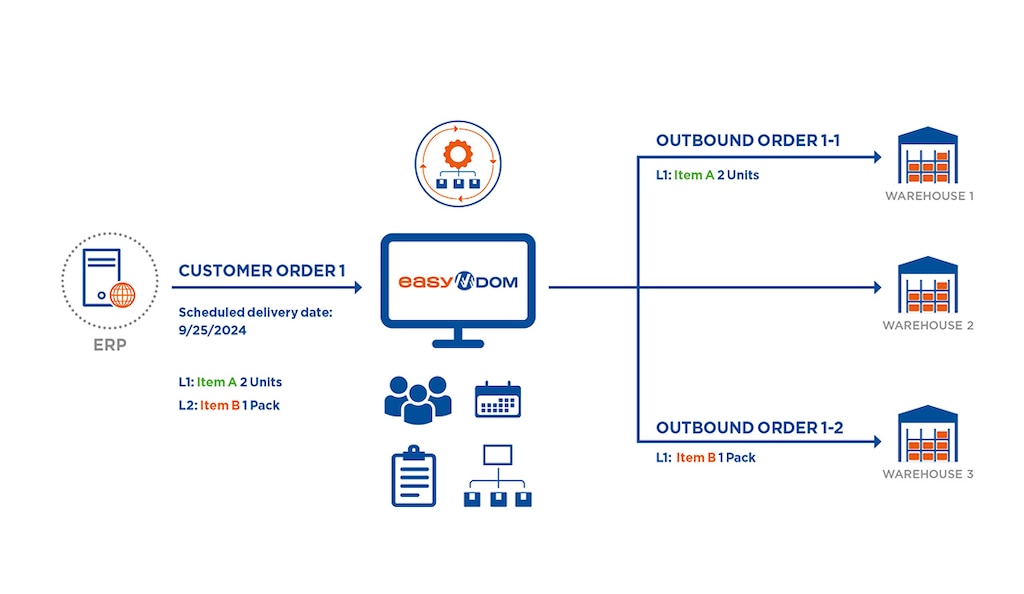
Order orchestration across multiple sales channels
Sales processes that follow an omnichannel strategy must offer customers convenient shopping and returns experiences. Managing and distributing these orders in the shortest possible time calls for intricate organization.
What is order orchestration?
Order orchestration is the process of coordinating, managing, and automating the multiple activities and resources involved in fulfilling orders across the supply chain. It includes syncing and optimizing order flows, inventory, and information to ensure efficient shipments across various channels, such as e-commerce, physical stores, and call centers. Overall, the order orchestration process addresses the following areas:
- Order receipt and validation
- Inventory management
- Order processing
- Logistics and distribution operations
- Communication and customer service
- Exchanges and returns
- Data analysis and optimization
Easy DOM, a software program dedicated to order orchestration, optimizes the selection of shipping locations through strategies that maximize cost-effectiveness. It aligns with companies’ business models through a set of prioritization rules, optimizing order routing and providing global inventory visibility.
Example
When a customer places an order online, a platform checks for available stock across multiple warehouses in a matter of seconds. It then allocates the inventory required to fulfill the order and generates the optimal shipping route, providing the user with this information in real time and continuously updating stock levels throughout the network.

Benefits of order orchestration
Order orchestration plays a crucial role in supply chain optimization by improving inventory management, enabling omnichannel strategies, increasing visibility, and facilitating returns. The customer experience is more satisfying, and stock turnover is optimized. This process has additional advantages. Companies can:
- Locate the best locations for assigning items to orders.
- Customize routing logic by applying rules to specific product groups.
- Manage order splitting and define the number of splits allowed per item or quantity to minimize shipping costs and enhance customer satisfaction.
- Configure allocation logic based on whether materials require special handling, for instance.
- Schedule downtime at certain locations.
To orchestrate or not to orchestrate?
If you’re a company with an online store and several distribution centers or physical stores, you most likely need order orchestration. It will enable you to establish specific rules for certain shipments and give you greater control over routes and inventory.
When you have a large network of sales points, order orchestration affords customers a seamless experience between online and offline channels. The end goal is to fulfill orders at the lowest possible cost while maintaining margins and providing excellent service.
Unrivaled customer experiences with order orchestration
Having an automated workflow lets you stand out from the competition by creating unique experiences. These are some of the options order orchestration offers:
- Grace periods, scheduled delivery dates, and subscriptions. Providing alternatives such as flexible deliveries can save money and boost customer satisfaction. Likewise, consumers value being able to choose when they’ll receive their purchases and opt into subscriptions.
- Kits and bundles. Creating sets makes it possible to pair slower-moving products with bestsellers, increasing average order totals.
- Preorders and backorders. By displaying and notifying users of estimated delivery times via a webpage, companies can accept preorders of items not yet in stock.
- Flexible returns. Facilitating this process (e.g., sending return labels before consumers request them) enhances the customer experience.

Order orchestration process
Regardless of the type of software used to manage it, order orchestration typically follows these steps:
- Order creation. When a customer makes a purchase, that information is sent to the central system.
- Fulfillment. Operators work on this process in three phases:
- Order picking, where operators group the items requested, a delivery note and shipping label are printed, and a tracking number is generated.
- Packing.
- Preparation for transportation.
- Transportation. When the company in charge of this phase picks the package up at that warehouse, the carrier scans it to update the status of the order. They will repeat the process as they advance on their journey until they reach the final destination.
- Inventory adjustment. Once items begin to be picked to fulfill an order, the central system updates stock levels in the internal application, ecommerce platform, and mobile apps.
- Returns management. Most orchestration systems already include an automatically generated label in case a product needs to be returned. When the facility receives the package, the refund or exchange is processed.
Differences between order orchestration and order management
While order management systems (OMS) manage an order’s life cycle, order orchestration programs coordinate all these processes so that your business isn’t overwhelmed by an increase in sales.
| OMS | Order orchestration |
|---|---|
| Provides traceability of sales, orders, inventory, and customer data from the beginning to the end of the transaction. | Automates specific steps and processes to ensure optimal order fulfillment. |
| Consists of an infrastructure encompassing the entire purchase process, from the point of sale to shipping. | Focuses on processing the order as efficiently as possible. |
|
|
Boost your business with DOM
If you’re looking to centralize management and your company follows an omnichannel strategy, a distributed order management (DOM) system will help you optimize supply chain order orchestration and maximize cost-effectiveness. At Interlake Mecalux, we developed proprietary software that aligns with each organization’s objectives and needs through multiple configurable business rules. Feel free to contact us for advice on this and other IT and warehousing solutions. Our company has been specializing in intralogistics solutions since 1966, and today, we have a team of over 400 engineers dedicated to software development.
